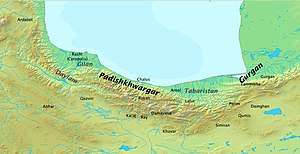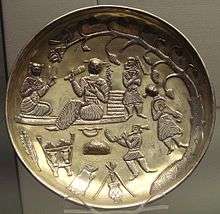Padishkhwargar
Padishkhwārgar was a Sasanian province in Late Antiquity, which almost corresponded to the present-day provinces of Mazandaran and Gilan. The province bordered Adurbadagan and Balasagan in the west, Gurgan in the east, and Spahan in south. The main cities of the province were Amol and Rasht.
Padishkhwargar | |||||||||||||||
|---|---|---|---|---|---|---|---|---|---|---|---|---|---|---|---|
| 224a – 520 520b – 651 | |||||||||||||||
 Map of northern Iran under the Sasanians | |||||||||||||||
| Capital | Amol Rasht | ||||||||||||||
| Common languages | |||||||||||||||
| Religion | Zoroastrianism Iranian paganism Christianity | ||||||||||||||
| Government | Monarchy | ||||||||||||||
| Historical era | Antiquity | ||||||||||||||
• Established | 224 | ||||||||||||||
• Disestablished | 651 | ||||||||||||||
| |||||||||||||||
The province functioned as some kind of vassal kingdom, being mostly ruled by princes from different royal families, who bore the title of Padashwargarshah ("Shah of Padishkhwargar").
Name
The name "Padishkhwargar" is the Bundahishn variation of its name. On Shapur I's inscription at the Ka'ba-ye Zartosht the province is called Parishkhwargar, whilst Islamic sources refer the region as Tabaristan,[1] which derives from Middle Persian Tapurstān (![]()
History

During the rise of the Sasanian dynasty, Padishkhwargar was ruled by a certain Gushnasp, who aided his suzerain the Parthian ruler Artabanus V (r. 213–224) in his struggle with the first Sasanian king (shah) Ardashir I (r. 224–242) over the control of Iran. Artabanus V was eventually defeated and killed, and Gushnasp was made a Sasanian vassal.[2] Gilan, which was never fully incorporated into the Sasanian Empire, still posed a problem for the Sasanians, as Ardashir's son and successor Shapur I (r. 240–270) had to make an expedition into the region in 242/3.[3] The dynasty of Gushnasp continued to rule Padishkhwargar until c. 520, when the Sasanian prince Kawus was made the new ruler of the province. After returning from an expedition in Zabulistan, Kawus rebelled in c. 532 against his recently crowned brother Khosrow I (r. 531–579), claiming himself as the rightful ruler of the empire due to being the elder brother.[4] He was defeated and executed the following year. In the 550s, Karin, a member of the House of Karen, received land to the south of Amol by Khosrow I, thus starting the Qarinvand dynasty.
Population
The western portion of Padishkhwargar included Gilan and Daylam, which was populated by the Gilaks and Daylamites, who were most likely adherents of some form of Iranian paganism, while a minority of them were Zoroastrian and Christian. According to al-Biruni, they "lived by the rule laid down by the mythical Afridun."[2] They were often associated with each other, and regularly served the Sasanian military as mercenaries, but never fully came under their suzerainty.[5][6] They both spoke a northern Iranian dialect that was mostly unintelligible with Persian.[6] The Cadusii, who had mixed with Gilaks, lived from the Caspian coast into the mountains. Mazandaran was populated by the Amardi and Tapur tribe, who had intermingled. The non-Iranian tribes of Amariacae and Dribices that lived from the range of Amol to Gurgan, had most likely been assimilated by the Iranians into a prevalent Mazandarani population.[7]
References
- Brunner 1983, p. 750.
- Madelung & Felix 1995, pp. 342-347.
- Frye 1983, p. 125.
- Pourshariati 2008, p. 288.
- Daryaee 2008, pp. 40-41.
- Madelung 2001, pp. 634-635.
- Brunner 1983, p. 766.
Sources
- Brunner, Christopher (1983). "Geographical and Administrative divisions: Settlements and Economy". The Cambridge History of Iran: The Seleucid, Parthian, and Sasanian periods (2). Cambridge: Cambridge University Press. pp. 747–778. ISBN 978-0-521-24693-4.CS1 maint: ref=harv (link)
- Pourshariati, Parvaneh (2008). Decline and Fall of the Sasanian Empire: The Sasanian-Parthian Confederacy and the Arab Conquest of Iran. London and New York: I.B. Tauris. ISBN 978-1-84511-645-3.CS1 maint: ref=harv (link)
- Madelung, Wilferd; Felix, Wolfgang (1995). "DEYLAMITES". Encyclopaedia Iranica, Vol. BII, Fasc. 4. pp. 342–347.CS1 maint: ref=harv (link)
- Daryaee, Touraj (2008). Sasanian Persia: The Rise and Fall of an Empire. I.B.Tauris. pp. 1–240. ISBN 0857716662.CS1 maint: ref=harv (link)
- Madelung, Wilferd (2001). "GĪLĀN iv. History in the Early Islamic Period". Encyclopaedia Iranica, Vol. X, Fasc. 6. pp. 634–635.CS1 maint: ref=harv (link)
- Frye, Richard N. (1983). "The political history of Iran under the Sasanians". The Cambridge History of Iran: The Seleucid, Parthian, and Sasanian periods (1). Cambridge: Cambridge University Press. pp. 116–181. ISBN 978-0-521-24693-4.CS1 maint: ref=harv (link)